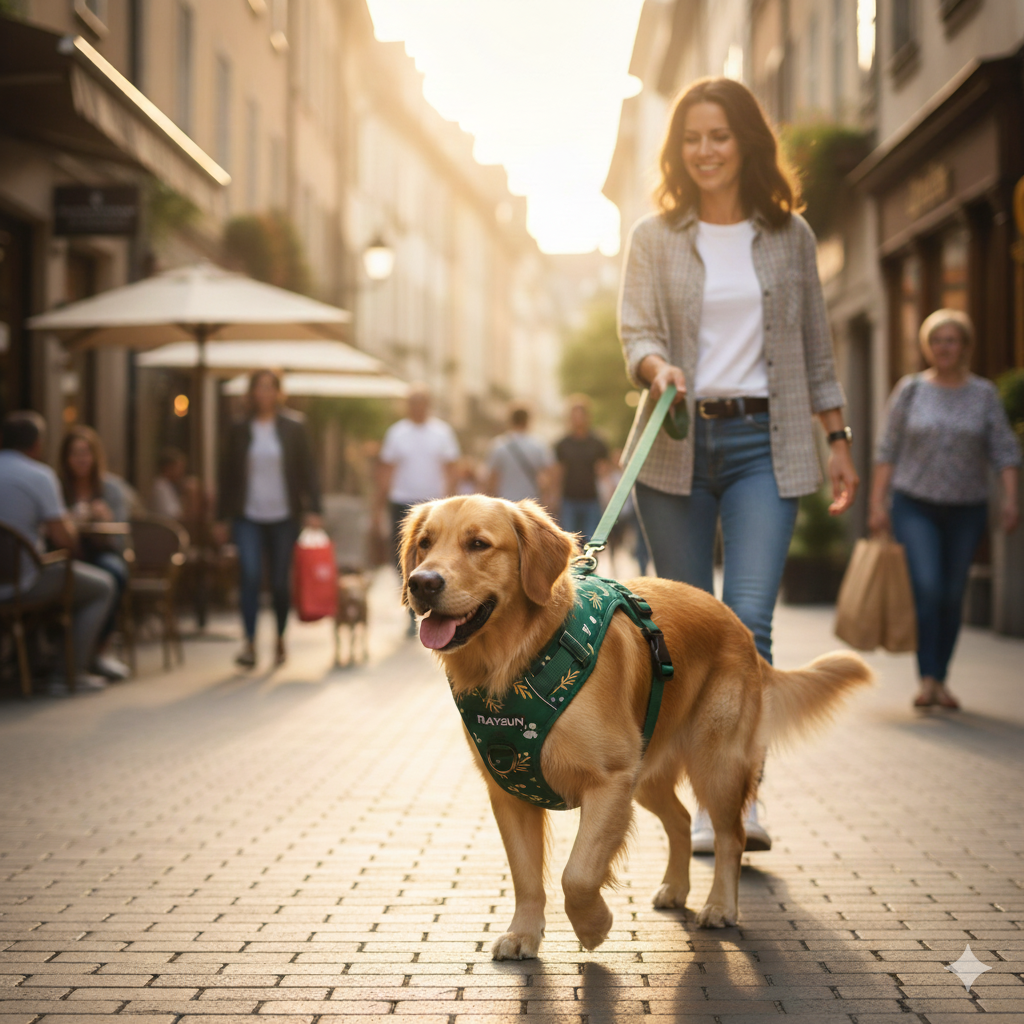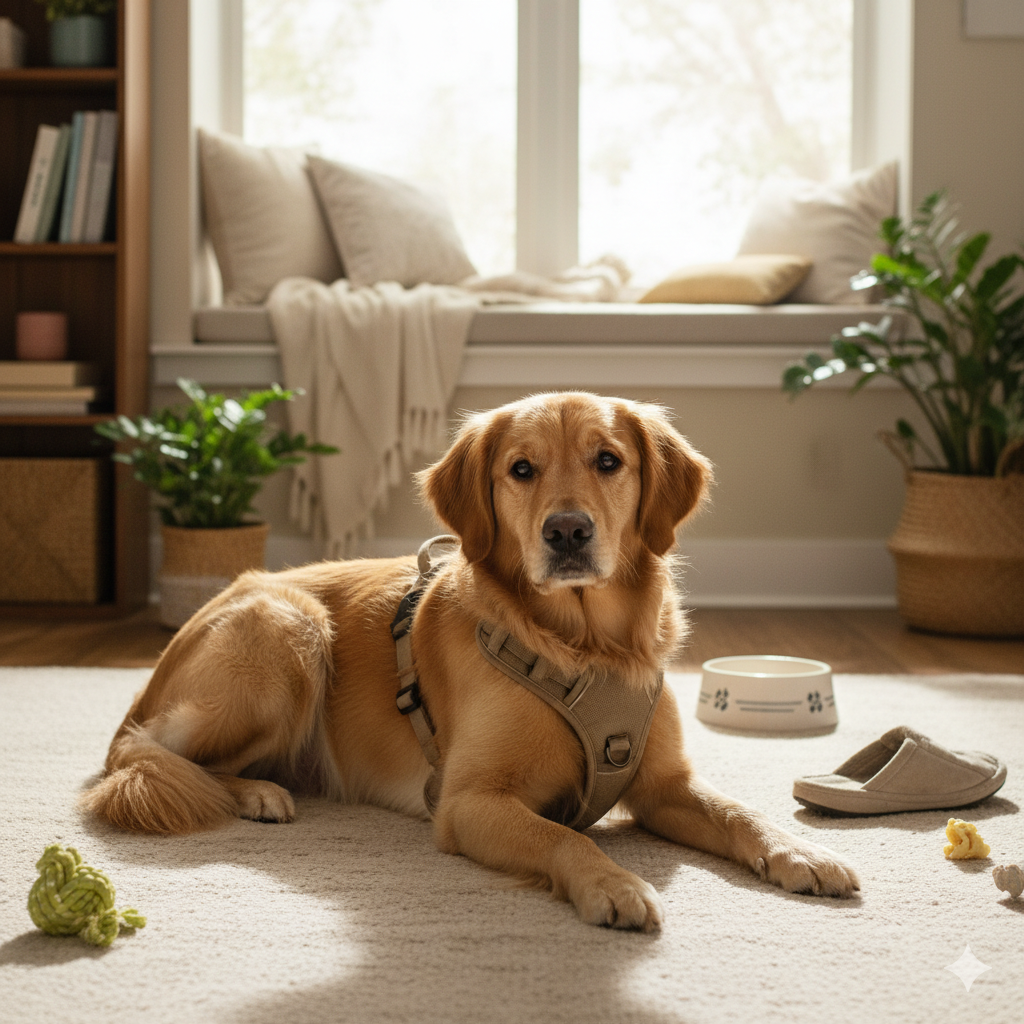Your dog pulls and gags on their collar, making walks a stressful battle. This constant strain can injure their neck, and you lose control. A good harness offers a safer solution.
Yes, dog harnesses are a fantastic tool for improving comfort, safety, and control. They distribute pressure across the dog’s chest and back, not the delicate neck. This helps prevent injury, discourages pulling, and gives you a much better handle on your dog during walks.

That point was driven home for me one weekend. My child, Frank, took our dog Lucky downstairs to play. The elevator doors started to close, but Frank didn't realize the leash was caught on the other side with Lucky. As the elevator moved, Lucky was pulled off his feet. It was terrifying. But he was wearing a harness, which distributed the force across his body. If he had been in a collar, he could have been choked. That day, I stopped seeing harnesses as just another accessory. I saw them as essential safety equipment. It’s why I’m so passionate about designing them correctly. Let's break down why they are so important.
Is it easier to control a dog on a harness?
Struggling to manage your lunging dog on walks? This lack of control is frustrating and can be dangerous. A harness can give you the leverage you need for calmer walks.
Yes, it is often much easier to control a dog on a harness, especially a front-clip one. This design redirects your dog’s forward momentum by turning them back towards you when they pull. It stops the pulling without any choking or pain.

From a design perspective, the mechanics are simple but effective. When a dog pulls on a leash attached to a collar or a back-clip harness, they can use their full body weight to move forward. It’s like a sled dog pulling a sled. A front-clip harness changes this completely. The leash attachment point is on the dog's chest. When they pull ahead, the tension on the leash gently turns their body to the side. They can't get the same forward drive. This gives you, the owner, a huge mechanical advantage. Back-clip harnesses are still great for well-trained dogs or small breeds, and they keep the leash from getting tangled in the dog’s legs. Many modern harnesses even have both clips to give you options.
Harness Clip Position and Control
| Clip Position | Best For | How it Works |
|---|---|---|
| Front-Clip | Strong pullers, training | Redirects forward motion, turning the dog back toward you. |
| Back-Clip | Calm walkers, small dogs, long-line training | Allows freedom of movement, no leash tangling under the body. |
| Dual-Clip | Versatility, maximum control | Use both clips with a double-ended leash for ultimate control. |
Are harnesses actually better for dogs?
Do you worry about your dog coughing or gagging on their collar? A collar puts direct pressure on the neck. This can cause pain and even long-term damage.
Absolutely. For most dogs, harnesses are medically safer than collars. They spread pulling force across the stronger chest and shoulder muscles. This protects the sensitive trachea, thyroid, and spine in the neck, which is especially vital for certain breeds.

When I design a piece of dog gear, I think about the dog’s anatomy first. The neck area contains the trachea (windpipe), the esophagus, the thyroid gland, and the cervical spine. A collar concentrates all pulling force right on this small, delicate area. This is very risky for brachycephalic (flat-faced) breeds like Pugs and French Bulldogs, who already have breathing issues. It’s also dangerous for small breeds like Yorkshire Terriers, who are prone to a condition called tracheal collapse. A well-designed harness bypasses the neck completely. The straps rest on the chest and around the rib cage. This design protects the neck from injury and doesn't restrict breathing. It also avoids putting pressure on the shoulder joints, allowing the dog to move naturally and comfortably. This focus on health and well-being is a core reason I advocate for harnesses.
Do dogs feel safer in a harness?
Does your dog get anxious or try to escape on walks? A scared dog can easily slip out of a collar. This leaves them vulnerable and you feeling helpless.
Many dogs do feel safer and more secure in a harness. The snug fit provides a gentle, constant pressure that can have a calming effect, much like a hug. It also makes it much harder for a dog to back out and escape.

This feeling of security is a real psychological benefit. Think of it like a weighted blanket or an anxiety vest for humans. The gentle, consistent pressure from a properly fitted harness can soothe an anxious dog. This is called deep pressure stimulation, and it helps calm their nervous system. This makes walks in busy or loud environments less stressful. Beyond the calming effect, there's the physical security. I've heard too many stories about dogs, especially those with narrow heads like greyhounds, slipping their collars and running off. A good harness, particularly one with a third strap around the waist, is virtually escape-proof. When the dog feels secure and the owner feels confident that the dog can't escape, the whole dynamic of the walk changes. You both become more relaxed, which builds a stronger, more trusting bond.
What are the benefits of a dog harness?
Are you looking for one tool that can improve walking in many ways? It's rare to find a single product that helps with training, safety, and comfort all at once.
Dog harnesses offer a package of benefits. They give you better control, prevent neck injuries, discourage pulling, and make dogs feel more secure. Many also have bonus features like handles for quick assistance and reflective trim for night visibility.

When we summarize the advantages, it becomes clear why harnesses are a superior choice for most dogs. The benefits work together to create a better walking experience for everyone. As a product developer, my goal is to pack as much function into a design as possible without sacrificing comfort or quality. A great harness does just that. It's a multi-functional tool that addresses the most common problems owners face. The variety available today is also a huge plus. You can find harnesses specialized for hiking, running, car safety, or for service dogs that need to carry patches or small packs. This versatility means there is a perfect harness out there for every dog and every situation.
A Summary of Key Harness Advantages
| Benefit | Description |
|---|---|
| Health and Safety | Prevents choking and neck injuries by distributing pressure across the chest. |
| Better Control | Front-clip designs give you leverage to easily redirect and manage a puller. |
| Training Aid | Discourages pulling without causing pain, making it a humane training tool. |
| Security | A snug fit prevents anxious or fearful dogs from backing out and escaping. |
| Comfort | Padded designs are comfortable for all-day wear on long adventures. |
| Extra Features | Many include handles for lifting/assisting and reflective trim for visibility. |
Conclusion
A dog harness is a superior choice. It provides safety, comfort, and control, making walks a more positive and enjoyable experience for both you and your beloved dog.
Cindy Long is the Sales Manager of Raysunpets and a pet lover with over 12 years of experience in exporting pet products. She specializes in providing customized dog chest carriers, leashes and pet accessory solutions for the European and American markets, always focusing on the real needs of customers and pets, and is committed to creating high-quality, practical and comfortable products that allow fur kids to live happier lives.


